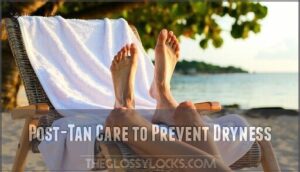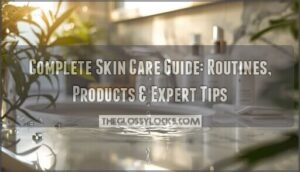This site is supported by our readers. We may earn a commission, at no cost to you, if you purchase through links.

The skin on your legs is thicker than elsewhere on your body, making it harder for UV rays to penetrate and trigger melanin production.
Regular shaving strips away developing color, while tight pants restrict blood flow that’s essential for healthy tanning.
Your legs also have fewer melanin-producing cells compared to your face and arms.
The good news? These barriers aren’t permanent roadblocks – they’re just challenges waiting for the right approach to overcome them completely, and with the right method, you can achieve a tan on your legs by addressing the issues of UV rays and blood flow.
Table Of Contents
- Key Takeaways
- Common Reasons Legs Won’t Tan
- How to Increase Melanin in Legs
- Preparing Legs for Tanning
- Top 4 Products to Help Legs Tan
- Tanning Legs Effectively
- Overcoming Common Tanning Concerns
- Maintaining Healthy Tanned Legs
- Frequently Asked Questions (FAQs)
- Why do legs not tan?
- Why are my legs so dry after a tan?
- Does tanning increase melanin in legs?
- Why should you tan your legs before or after tanning?
- Can You tan your legs inside a tanning bed?
- Does UV light tan your legs?
- How can I tan my pale legs?
- What is the hardest part of the body to tan?
- Why is it so difficult to tan your legs?
- Why do my legs get a golden tan?
- Conclusion
Key Takeaways
- Your legs have thicker skin and fewer melanin-producing cells – This creates a natural barrier that blocks UV rays and slows down the tanning process compared to your face and arms.
- Prepare your legs properly before tanning – You’ll need to exfoliate 24 hours beforehand, moisturize regularly, and wear loose clothing to improve blood circulation for better results.
- Use targeted products to overcome stubborn areas – Tanning accelerators, self-tanning mousses, and bronzing oils can help your legs develop color when natural tanning isn’t working effectively.
- Build your tan gradually with consistent care – You’ll achieve better, longer-lasting results by rotating positions during sun exposure, staying hydrated, and maintaining your tan with regular exfoliation and moisturizing.
Common Reasons Legs Won’t Tan
You’ve probably noticed that your legs stubbornly resist tanning while your face and arms darken easily, leaving you with an uneven complexion that screams "vacation fail."
Several factors work against your legs in achieving that golden glow you’re after.
Legs Have Thicker Skin
Your legs’ thicker skin creates a natural barrier that blocks UV rays from penetrating deep enough to trigger effective melanin production.
Your legs fight back against tanning with thicker skin that blocks those golden rays from doing their magic.
This skin thickness on legs averages 2.2mm compared to facial skin at just 1.3mm, making UV penetration substantially harder and slowing leg pigmentation.
Maintaining proper skin hydration methods is essential for overall skin health.
Here’s how to work with your leg’s unique structure:
- Exfoliate regularly to thin the protective barrier and improve UV absorption
- Use tanning accelerators specifically formulated to boost melanin production in thicker skin areas
- Moisturize consistently to prevent dryness that reflects UV rays away from your skin
- Be patient – legs naturally require 40-60% longer tanning time than other body areas
Limited Melanin Production
Your genetics determine your melanin levels, making some people naturally tan-resistant.
If you’ve got fair skin pigment, your legs produce less melanin even with UV exposure.
This genetic lottery affects melanin production differently across body parts.
Tanning genetics can’t be changed, but understanding why your legs aren’t tanning helps you choose better solutions.
Hair Removal and Dry Skin
Hair removal practices can throw off your tanning game. Shaving Tips and Waxing Effects disrupt skin’s surface layer, removing melanin-rich cells that help legs darken. Dry skin on legs creates barriers that block UV absorption.
Here’s how Hair Removal affects tanning:
- Exfoliation Methods like shaving strip away tanned skin cells
- Dry Skin Care becomes essential since dry skin legs resist tanning products
- Hair Regrowth timing impacts when you should exfoliate legs tan
Tight Clothing and Poor Circulation
Circulation problems can sabotage your tanning goals before you even start.
When tight clothing creates leg constriction, it restricts blood flow and reduces the oxygen your skin needs for proper melanin production.
Here’s how to fix circulation issues:
- Wear loose, breathable fabrics that don’t restrict blood flow
- Exercise regularly to boost circulation and improve poor circulation legs
- Avoid clothing restrictions that cause difficulty tanning legs and keep legs pale
How to Increase Melanin in Legs
You can support melanin production in your legs through targeted nutrition, though results won’t be dramatic or immediate.
Foods rich in antioxidants, vitamin A, vitamin C, and vitamin E help your skin cells function at their best and may enhance your body’s natural pigment-making process.
Antioxidant-Rich Diet for Enhanced Melanin Production
Antioxidants act as your skin’s defense system, protecting melanocytes from UV damage while supporting melanin production legs.
These skin nutrition powerhouses help tan resistant skin develop more even pigmentation.
| Antioxidant | Melanin Boosting Food |
|---|---|
| Vitamin C | Citrus, bell peppers |
| Vitamin E | Almonds, sunflower seeds |
| Selenium | Brazil nuts, mushrooms |
| Zinc | Chickpeas, pumpkin seeds |
Antioxidant foods provide essential vitamin intake for enhanced skin health and natural tanning abilities.
Dark Leafy Greens and Berries for Melanin Boost
Your skin’s ability to tan improves when you fuel it with the right nutrients.
Dark leafy greens like spinach and kale, along with blueberries and blackberries, provide powerful antioxidants that support melanin production in your legs.
Here are five melanin-boosting foods to include in your diet:
- Spinach – Rich in vitamins A and C for skin health
- Blueberries – Packed with anthocyanins that protect skin cells
- Kale – Contains beta-carotene for enhanced nutrient absorption
- Blackberries – High in vitamin E for antioxidant boost
- Arugula – Provides folate supporting healthy melanin function
These berry benefits and green supplements won’t instantly fix legs not tanning, but they’ll gradually improve your skin’s natural tanning response and help prevent uneven tan legs.
Spinach, Peas, Grains, Seeds, and Nuts for Melanin Enhancement
Certain foods can be powerful dietary enhancers for melanin production, though results won’t happen overnight.
These melanin boosters work by providing essential nutrients that support your skin’s natural pigment-making process, which can help address issues like legs not tanning evenly.
Here are three key nutrient absorption champions for your skin:
- Spinach and peas – Rich in folate and vitamin K for cellular health
- Whole grains – Provide B vitamins essential for melanin synthesis
- Seeds and nuts – Pack vitamin E and healthy fats for skin hydration
These antioxidant rich foods won’t magically transform your uneven tan legs overnight, but they’ll give your skin the building blocks it needs.
Think of them as internal leg tanning tips that work from the inside out.
While you’re munching on these seed benefits, remember that proper skin hydration and sun protection remain essential for healthy melanin development.
Preparing Legs for Tanning
Getting your legs ready for tanning takes some strategic preparation to overcome their natural resistance to color change.
You’ll need to exfoliate dead skin cells, moisturize properly, and create the right conditions for UV absorption about 24 hours before your tanning session.
Exfoliate 24 Hours Prior to Tanning
Perfect skin preparation starts with gentle exfoliation twenty-four hours before tanning.
Use a soft mitt with organic body wash to remove dead cells, creating a smooth canvas for even absorption.
This exfoliation tip prevents streaking and helps your tan enhancement products penetrate evenly.
Proper skin exfoliation timing allows your legs to recover while maximizing tanning results.
Effective use of exfoliating tools can substantially improve the exfoliation process.
Moisturize Legs to Enhance UV Absorption
Moisture acts as your secret weapon for achieving that coveted leg tan you’ve been chasing.
When you moisturize your legs properly, you’re creating the perfect canvas for UV rays to work their magic on stubborn areas that refuse to darken.
Skin hydration transforms rough, flaky surfaces into smooth terrain that absorbs sunlight evenly, preventing patchy results that’ll leave you frustrated.
Proper skin care routines with hydration strategies can substantially improve the tanning process.
Apply Tanning Lotions or Accelerators
Using tanning oils and accelerators gives your legs the extra boost they need.
Choose products with tyrosine or DHA for enhanced melanin production. Apply in upward circular motions from feet to thighs for even coverage.
Accelerator tips: these tan enhancers need UV exposure, while self tanner for legs works independently for stubborn areas that won’t darken.
When selecting products, consider the benefits of tanning lotions to achieve the desired skin tone.
Wear Loose Clothing for Better Circulation
Blood circulation affects how well your legs tan, so loose clothing becomes essential for skin health.
Tight garments restrict blood flow, preventing oxygen from reaching skin cells needed for tan enhancement.
- Choose loose fabrics like cotton or linen that won’t constrict circulation
- Avoid skinny jeans or tight leggings that squeeze your legs
- Wear flowing pants or skirts to promote healthy skin circulation
Top 4 Products to Help Legs Tan
When your legs struggle to develop that golden glow, the right products can make all the difference in achieving an even tan.
These four carefully selected tanning solutions work with your leg’s unique skin characteristics to overcome common barriers like thicker skin and reduced melanin production.
1. Natural Self Tanning Oil Spray
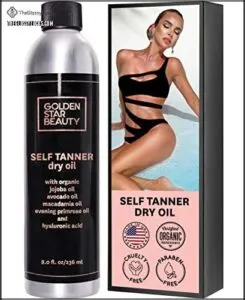
Natural oils offer your legs the sun-kissed glow they’ve been craving without harsh chemicals.
These tanning sprays contain nourishing ingredients like jojoba and avocado oils that hydrate while darkening your skin.
Skin prep matters—exfoliate beforehand for smooth application and even color development.
Oil benefits include quick absorption and natural-looking results that won’t turn you orange.
Apply these selftanner products in circular motions, ensuring complete coverage on areas where legs wont darken naturally.
A tanning mitt prevents streaky application and protects your palms.
These spray tan legs solutions work faster than traditional tanning lotion legs formulas.
Tanning tips: start light and build gradually for the most natural fake tan legs appearance.
Best For: Quick-drying, natural-looking results with organic ingredients.
2. Skinerals Self Tanning Mousse
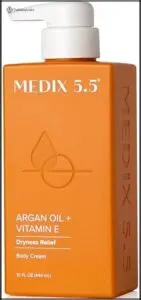
Struggling with pale legs that refuse to cooperate? Skinerals Self Tanning Mousse delivers professional results without stepping foot in a salon.
This self tanning formula creates an even, streak-free glow lasting seven days. Perfect for legs wont darken situations, the quick-drying mousse hydrates with plant-based oils while eliminating typical selftanner odors.
Mousse application requires a tanning mitt for maximum coverage. The lightweight formula works as an effective tanning lotion legs solution, providing fake tan legs results that rival spray tan legs treatments.
Skin preparation beforehand guarantees maximum absorption. Tanning tips: Apply in circular motions for seamless blending.
Best For: Natural-looking, salon-quality results at home.
3. Argan Oil Body Cream Anti Aging
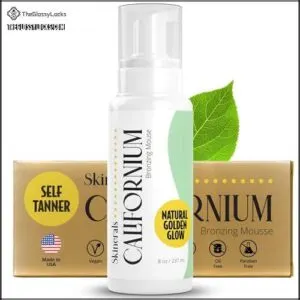
Several powerful ingredients make this argan oil body cream a standout choice for stubborn legs that resist tanning. Argan Oil Benefits include deep moisturization that prepares your skin for even color development, while the cream’s anti-aging formula works double duty.
The rich blend combines argan oil’s nourishing properties with shea butter and vitamin E for superior Skin Hydration. These Moisturizing Techniques help create the ideal canvas for tanning by softening thick leg skin and improving UV absorption.
Daily Cream Applications deliver gradual results – massage into clean legs using upward strokes for best absorption. The Anti Aging Tips here are simple: consistent moisturization plumps skin cells, reducing fine lines while enhancing your natural tanning ability.
This approach to skin care transforms how your legs respond to sun exposure, creating smoother, more receptive skin that develops color more evenly than untreated areas.
Best For: Those seeking natural-looking color enhancement while addressing signs of aging on legs.
4. Pacifica Mineral Bronzing Sunscreen Spray
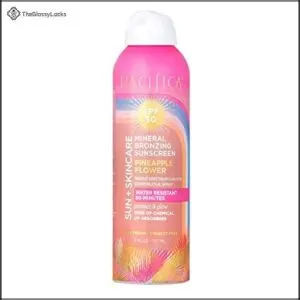
The Pacifica Mineral Bronzing Sunscreen Spray offers dual benefits for your legs – UV Defense with SPF 30 and a subtle Bronzing Tips effect.
This Mineral Sunscreen uses zinc oxide for gentle Skin Protection while creating a natural skin tone boost.
Perfect for legs prone to uneven tan issues, it helps even out coloring during sun exposure.
However, Spray Application can stain clothing and may streak when wet.
For best tanning results, apply evenly and allow proper drying time.
Best For: Light bronzing effect with reliable sun protection.
Tanning Legs Effectively
Now that you’ve got the right approach, proper technique becomes essential for actually tanning those stubborn legs.
Understanding how to position yourself and care for your skin afterward will make the difference between patchy results and that even golden glow you’re after.
Position Changes for Even Tanning
Switch up your tanning positions every 15-20 minutes to achieve even UV exposure on your legs.
When outdoor tanning legs, rotate from lying on your back to your stomach, adjusting body alignment for maximum skin flexibility.
These strategic tanning angles prevent uneven tan lines and guarantee consistent color development across all leg surfaces.
Rotate and Reapply for Better Results
Rotating regularly during UV exposure prevents uneven tanning on your legs.
Change positions every 10-15 minutes, whether you’re indoor tanning legs or outdoor tanning legs.
Reapply tanning lotions after each rotation to maintain consistent sun exposure legs coverage.
These tanning positions guarantee all angles receive adequate UV exposure, eliminating shadowy spots for uniform results across your legs.
Post-Tan Care to Prevent Dryness
After your rotation routine, your skin needs proper post-tan care to lock in results.
Apply a rich moisturizer within minutes to combat skin dryness. Choose aftercare products with ceramides or shea butter for lasting skin hydration.
Gentle dry skin remedies like aloe vera soothe irritation while supporting tan maintenance. Proper care prevents flaking and extends your glow.
Embracing Gradual Tanning for Natural Results
Patience pays off with gradual tanning for naturally sun-kissed legs. Build your tan slowly over multiple sessions instead of rushing the tanning process.
This approach prevents pale legs from burning while allowing your skin preparation to work effectively. Gradual leg tan development responds better to controlled UV exposure, creating even natural results without streaks or harsh lines.
To maintain healthy and glowing skin, this is key to follow effective skin care habits.
Tanning mitt
Overcoming Common Tanning Concerns
You’re not alone if your legs seem resistant to tanning despite your best efforts.
Understanding why legs tan differently and knowing the right techniques can help you achieve that even, golden glow you’ve been working toward.
Uneven Tanning and Pale Legs
Uneven tan blues got you down? Your legs face unique tanning difficulties due to lower melanin levels and increased skin thickness compared to your torso.
These factors create natural barriers to UV exposure, making legs tanning a slower process. Combat pale legs by addressing circulation issues—tight clothing restricts blood flow that’s essential for melanin production.
Focus on proper leg care through consistent exfoliation and moisturizing to remove dead skin barriers. Consider tanning tips like using bronzing accelerators specifically designed for stubborn areas.
Remember, an uneven tan doesn’t mean failure—your leg tan will develop with patience and the right approach. Maintaining healthy skin through skin health practices is also vital for achieving a more even tan.
Tanning Time and Skin Thickness
Your legs take longer to tan because of skin thickness and limited melanin production.
Thicker leg skin blocks UV rays absorption, requiring extended tanning time.
With fewer melanocytes, skin pigmentation develops slowly.
Regular leg exfoliation removes barriers, improving UV penetration.
Tanning delays happen naturally—patience pays off with consistent sun exposure and proper preparation techniques.
Protecting Legs From Sunburn and UV Rays
While tanning requires exposure, protecting your skin from harmful UV rays prevents painful sunburn and long-term damage.
Smart sunbathing means finding the balance between achieving color and maintaining healthy skin.
Here’s your protection playbook:
- Apply broad-spectrum SPF 30+ sunscreen – reapply every two hours for continuous UV protection
- Choose UPF-rated clothing when possible – loose, dark fabrics block up to 98% of harmful rays
- Limit peak sun hours (10 AM-4 PM) to reduce UV radiation exposure by half
Maintaining Healthy Tanned Legs
Once you’ve achieved that coveted leg tan, keeping it vibrant requires consistent care and smart product choices.
The right maintenance routine will help your tan last longer while keeping your skin healthy and glowing.
Hydrate and Exfoliate Regularly
Maintaining healthy, tanned legs starts with consistent skin care routines.
Exfoliate weekly using a hydrating scrub to remove dead cells that block UV rays. Moisturizing benefits include improved skin moisture and enhanced tan enhancement.
Quality skin exfoliants paired with effective hydration methods create ideal conditions.
Proper skin hydration through daily moisturizing guarantees your legs absorb and retain color more effectively than neglected skin.
Use Tan Accelerators and Self-Tanners Wisely
When you’re struggling to achieve that golden glow on your legs, tan accelerators and self tanning products become your best allies.
Choose quality tanning serums and skin enhancers that match your skin tone. Apply self tanner evenly using circular motions after proper skin preparation techniques.
Follow accelerator tips by starting with thin layers for natural tan development. Smart use of tanning products prevents streaking and guarantees lasting results.
For a safer and more natural approach, consider using products with organic self tanner ingredients to achieve a healthy glow.
Frequently Asked Questions (FAQs)
Why do legs not tan?
Your legs resist tanning because they produce less melanin, have thicker skin that blocks UV rays, and receive poor blood circulation compared to your torso and face.
Why are my legs so dry after a tan?
Your thirsty skin basically drinks up all its moisture during tanning sessions. UV exposure dehydrates skin cells while heat evaporates natural oils, leaving your legs feeling like sandpaper afterward.
Does tanning increase melanin in legs?
Yes, tanning stimulates melanin production in your legs, though they’ll respond slower than other body areas.
Your legs naturally produce less melanin due to thicker skin and reduced blood circulation, making the tanning process more gradual but still effective.
Why should you tan your legs before or after tanning?
You should tan your legs at the same time as the rest of your body for even color distribution.
Tanning legs separately can create obvious tan lines and uneven pigmentation that’s hard to blend naturally.
Can You tan your legs inside a tanning bed?
Ironically, tanning beds can actually work better for legs than natural sunlight.
You’ll get more even exposure since you can position your legs properly and avoid shadows.
Traditional beds focus on your upper body, but you can adjust positioning or use stand-up beds for better leg coverage, and this allows for more even exposure.
Does UV light tan your legs?
UV light can tan your legs, but they’re naturally resistant.
Your leg skin is thicker, has less melanin, and gets poorer blood circulation than your torso, making them slower to develop color even with proper UV exposure.
How can I tan my pale legs?
Exfoliate legs gently, then moisturize daily with oil-free lotion. Use gradual tanning products or bronzing drops mixed with moisturizer. Position legs properly when sunbathing, changing angles frequently for even coverage.
What is the hardest part of the body to tan?
Picture stubborn patches that seem immune to golden rays – your legs rank among the body’s most challenging areas to tan.
They produce less melanin, have thicker skin blocking UV penetration, and suffer from poor circulation compared to your torso and arms.
Why is it so difficult to tan your legs?
Your legs resist tanning because they produce less melanin, have thicker skin that blocks UV penetration, and suffer from poor blood circulation compared to your upper body areas.
Why do my legs get a golden tan?
Your legs develop a golden tan because melanin production creates warm, honey-colored pigments when exposed to UV light.
This golden hue comes from your skin’s natural protective response to sun exposure.
Conclusion
Like a stubborn puzzle missing key pieces, your legs resist tanning due to thicker skin, fewer melanin-producing cells, and circulation barriers.
However, understanding why won’t my legs tan empowers you to overcome these challenges.
Through proper exfoliation, moisturizing, dietary changes, and strategic product use, you’ll release your legs’ tanning potential.
Remember that patience pays off—gradual progress beats rushed results every time.
- https://www.tanbythesea.com/post/the-importance-of-hydration-for-tanning
- https://www.blushtansandiego.com/blog/the-impact-of-hydration-on-your-spray-tan-why-drinking-water-matters
- https://world.comfortzoneskin.com/blogs/blog/skin-hydration-101-the-correct-way-to-use-body-lotion
- https://petajanebeauty.com/blogs/news/is-your-moisturizer-ruining-your-tan
- https://www.shinetanningsolutions.com/post/hydration-and-tanning-why-it-matters








